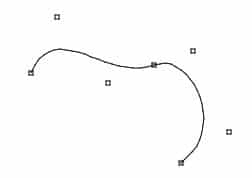
Studio Artist has 5 different Bezier Path Memories. Four of them are global memories and one is internal to the paint synthesizer. The bezier path memories can be used to record, store, and playback sets of bezier paths.
You can use the path memories as working storage when editing a bezier sketch or animation. You can also use the path memories to build paint synthesizer presets that incorporate bezier paths or shapes as a part of the way a paint preset draws. This tip will discuss how to work with the bezier path memories.
Each Studio Artist layer consists of a raster image buffer as well as a bezier path frame. The current layer’s bezier path frame is normally hidden from view but is displayed in the working canvas when you are in bezier operation mode.
Each of the 5 bezier path memories can record, store, and playback one or more bezier paths. The bezier path memories playback their contents into the current layer’s bezier path frame. Or they can record a snapshot of the current layer’s bezier path frame into their internal storage for playback at some later time. The contents of the bezier path memories are also available in the paint synthesizer, and can be used to define dynamic path shapes or path start locations.
There are 2 different ways to access the individual bezier path memories. As shown in the screen shot at the top of this post, you can use the Path : Path Memories menu commands to playback or record the contents of the one internal and 4 global path memories. You can also use the bezier memory toolbar located at the bottom of the bezier editor to access the path memories as memory buttons.

Like all Studio Artist memory buttons, you option click them to record the current contents of the interface into the memory button, and click them to playback their contents into the interface. Since they are bezier path memory buttons, the current interface content refers to the state of the current layer’s bezier path frame.
Bezier paths are a kind of mathematical spline curve which you can think of as a series of contiguous points that define a smooth flexible curve. The smooth bezier curve is defined by a series of control points which you can use to adjust the shape and position of the curve. The screen shot below shows a bezier curve consisting of 3 control points on the curve and 2 sets of additional control points (or handles) that define the shape of the curve between the 3 on-curve control points.

Embedding Bezier Paths in a Paint Preset

The BezSmartHatch1 paint preset in the Auto Sketch category is an example of a paint preset that incorporates an embedded set of bezier paths. The bezier paths are stored in the internal bezier path memory and are used to define a cross hatch pattern. An example of a cross hatch sketch created with this preset is shown above.
If you import the BezSmartHatch paint preset, switch to Bezier operation mode, and then click the internal path memory button at the bottom of the bezier editor palette,then the contents of the internal bezier path memory will be displayed in the working canvas. The screen shot below shows the 4 bezier paths that make up the set of bezier paths used for the cross hatch patterning generated by the paint preset.


You can customize the cross hatch pattern any way you want by drawing your own set of bezier paths and then recording them in the internal bezier path memory. For example, i switched to bezier operation mode and then used bezier draw to create the following new circular spiral hatch pattern.


I then generated a new cross hatch sketch with the new custom hatch patterning i created. To save a new preset with the custom bezier hatch pattern stored in the internal bezier path memory you can just export the modified paint preset.







